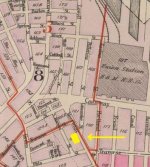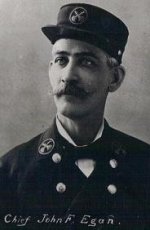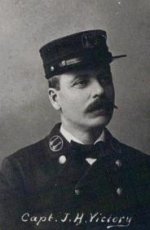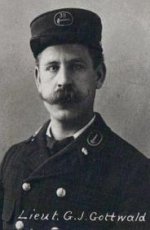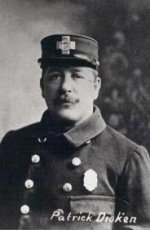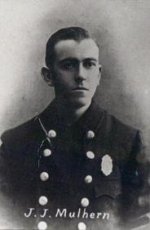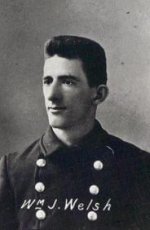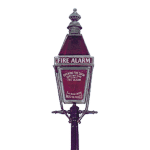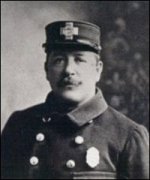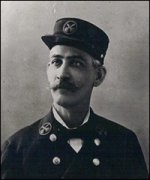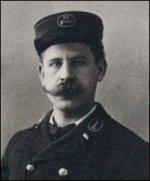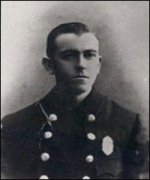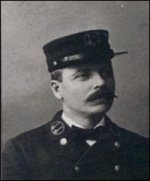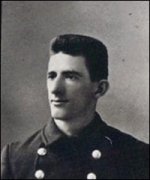Boston Fire Department Line of Duty Deaths
February 5, 1898 - Boston, MA. 6 Firefighters - LODDS
District Chief John F. Egan, 48 - Battalion 3
Captain James H. Victory, 44 - Engine 38-39
Lieutenant. George J. Gottwald - Engine 38-39
Horseman William J. Welch - Engine 38-39
Hoseman John J. Mulhern - Engine 38-39
Hoseman Patrick H. Disken, 39 - Engine 38-39
On the February 5, 1898 at about 0355 hours Box 412, Causeway and Lowell Streets, was pulled by Patrolman Sheehan of Division 3 for a fire at the George Bent Bedding Company at 116-126 Merrimac Street. Fire and smoke were showing when the first companies arrived. Assistant Chief William Cheswell ordered a 2nd alarm on his arrival and ordered lines of hose be run to the interior by the stairs and also by ground ladders from the outside. A very heavy snow storm, a few days before, had covered everything and Engine Companies were having trouble getting water from the snow covered hydrants. Some were frozen. A 3rd alarm was ordered at 0416 hours.
The building was 5 stories and about 125’ wide x 75’ deep. In addition, it was loaded with large amounts of feathers, excelsior, and other materials used in the manufacturing of furniture and mattresses.
Responding on the 2nd alarm was District Chief Egan from Fort Hill Square, Captain Garrity, and Lieutenant O’Connor of Engine Company 7 from East Street. District Chief Egan went to the 4th floor with Engine Company 7 where they would be operating their line. Engine 39 had run lines there also and now District Chief Egan took command of this area.
At about 0515 hours, when the fire was just about under control, the roof collapsed into the 5th floor and all floors came down. Lieutenant O’Connor, of Engine Company 7, had just spoken with District Chief Egan and knew about where he should be. Members started to dig and due to the very heavy fire load and snow, it took a lot of time to work.
Fire Commissioner Russell sent for heavy equipment and stevedores to help remove the heavy timbers. The first member found was Hoseman Shea of Engine Company 7 at 0622; he was found about 40’ from the front building. Next was Captain Garrity also of Engine Company 7. Just after 0700 hours, the two remaining members of Engine Company 7 were found. They were Hosemen Conroy and Doherty. These men were injured and removed to Massachusetts General Hospital.
District Chief Egan was found about 1000 hours and right behind him was Captain James Victory of Engine Company 38-39. Both men were alive when brought out and were given the "Last Rights" by Fr. Finnegan of St. Mary’s Church in the North End. They both died a short time after. Hosemen Disken and Mulhern were found about 1010 hours. The last two men, Hoseman Welch and Lieutenant Gottwald, were found about 1145 hours. Lieutenant Gottwald suffocated from being covered with feathers! Lieutenant Gottwald's grandson joined the department and also become a lieutenant. Ironically, he would also die in the line of duty on March 3rd, 1970. Three of his great-grandsons also went on to become Boston firefighters.
Not long after all the men were removed, a controversy started as to the cause of the collapse. There had been a fire in this building a few years before and the Building Commissioner, Damrell, stated that repairs were made. Other people were not sure. Superintendent Abbott, of the Protective Department, said, "he wouldn’t send men in there as it was a dangerous building." Chief of Department Webber stated, "At the time of the falling of the floors there had at no time been fire enough on either floor to weaken the supports to such an extent as to make the building dangerous and the crash came without warning!"
Whatever the cause was, six firemen were dead and a number injured. Most of the injured returned to work within a few days or weeks.
Funds were started for the members’ families by two different Boston newspapers, the "Globe" and "Post." The total amount raised was over $50,000; a lot of money for 1898.
Running Card for Box 412, Causeway and Lowell Streets (1898)
February 5, 1898 - Boston, MA. 6 Firefighters - LODD
On the February 5, 1898 at about 0355 hours Box 412, Causeway and Lowell Streets, was pulled by Patrolman Sheehan of Division 3 for a fire at the George Bent Bedding Company at 116-126 Merrimac Street. Fire and smoke were showing when the first companies arrived. Assistant Chief William Cheswell ordered a 2nd alarm on his arrival and ordered lines of hose be run to the interior by the stairs and also by ground ladders from the outside. A very heavy snow storm, a few days before, had covered everything and Engine Companies were having trouble getting water from the snow covered hydrants. Some were frozen. A 3rd alarm was ordered at 0416 hours.
The building was 5 stories and about 125’ wide x 75’ deep. In addition, it was loaded with large amounts of feathers, excelsior, and other materials used in the manufacturing of furniture and mattresses.
Responding on the 2nd alarm was District Chief Egan from Fort Hill Square, Captain Garrity, and Lieutenant O’Connor of Engine Company 7 from East Street. District Chief Egan went to the 4th floor with Engine Company 7 where they would be operating their line. Engine 39 had run lines there also and now District Chief Egan took command of this area.
At about 0515 hours, when the fire was just about under control, the roof collapsed into the 5th floor and all floors came down. Lieutenant O’Connor, of Engine Company 7, had just spoken with District Chief Egan and knew about where he should be. Members started to dig and due to the very heavy fire load and snow, it took a lot of time to work.
Fire Commissioner Russell sent for heavy equipment and stevedores to help remove the heavy timbers. The first member found was Hoseman Shea of Engine Company 7 at 0622; he was found about 40’ from the front building. Next was Captain Garrity also of Engine Company 7. Just after 0700 hours, the two remaining members of Engine Company 7 were found. They were Hosemen Conroy and Doherty. These men were injured and removed to Massachusetts General Hospital.
District Chief Egan was found about 1000 hours and right behind him was Captain James Victory of Engine Company 38-39. Both men were alive when brought out and were given the "Last Rights" by Fr. Finnegan of St. Mary’s Church in the North End. They both died a short time after. Hosemen Disken and Mulhern were found about 1010 hours. The last two men, Hoseman Welch and Lieutenant Gottwald, were found about 1145 hours. Lieutenant Gottwald suffocated from being covered with feathers! Lieutenant Gottwald's grandson joined the department and also become a lieutenant. Ironically, he would also die in the line of duty on March 3rd, 1970. Three of his great-grandsons also went on to become Boston firefighters.
Not long after all the men were removed, a controversy started as to the cause of the collapse. There had been a fire in this building a few years before and the Building Commissioner, Damrell, stated that repairs were made. Other people were not sure. Superintendent Abbott, of the Protective Department, said, "he wouldn’t send men in there as it was a dangerous building." Chief of Department Webber stated, "At the time of the falling of the floors there had at no time been fire enough on either floor to weaken the supports to such an extent as to make the building dangerous and the crash came without warning!"
Whatever the cause was, six firemen were dead and a number injured. Most of the injured returned to work within a few days or weeks.
Funds were started for the members’ families by two different Boston newspapers, the "Globe" and "Post." The total amount raised was over $50,000; a lot of money for 1898.
Running Card for Box 412, Causeway and Lowell Streets (1898)

District Chief John F. Egan, 48 - Battalion 3

Captain James H. Victory, 44 - Engine 38-39

Lieutenant. George J. Gottwald - Engine 38-39

Horseman William J. Welch - Engine 38-39
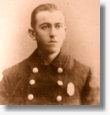
Hoseman John J. Mulhern - Engine 38-39

Hoseman Patrick H. Disken, 39 - Engine 38-39

